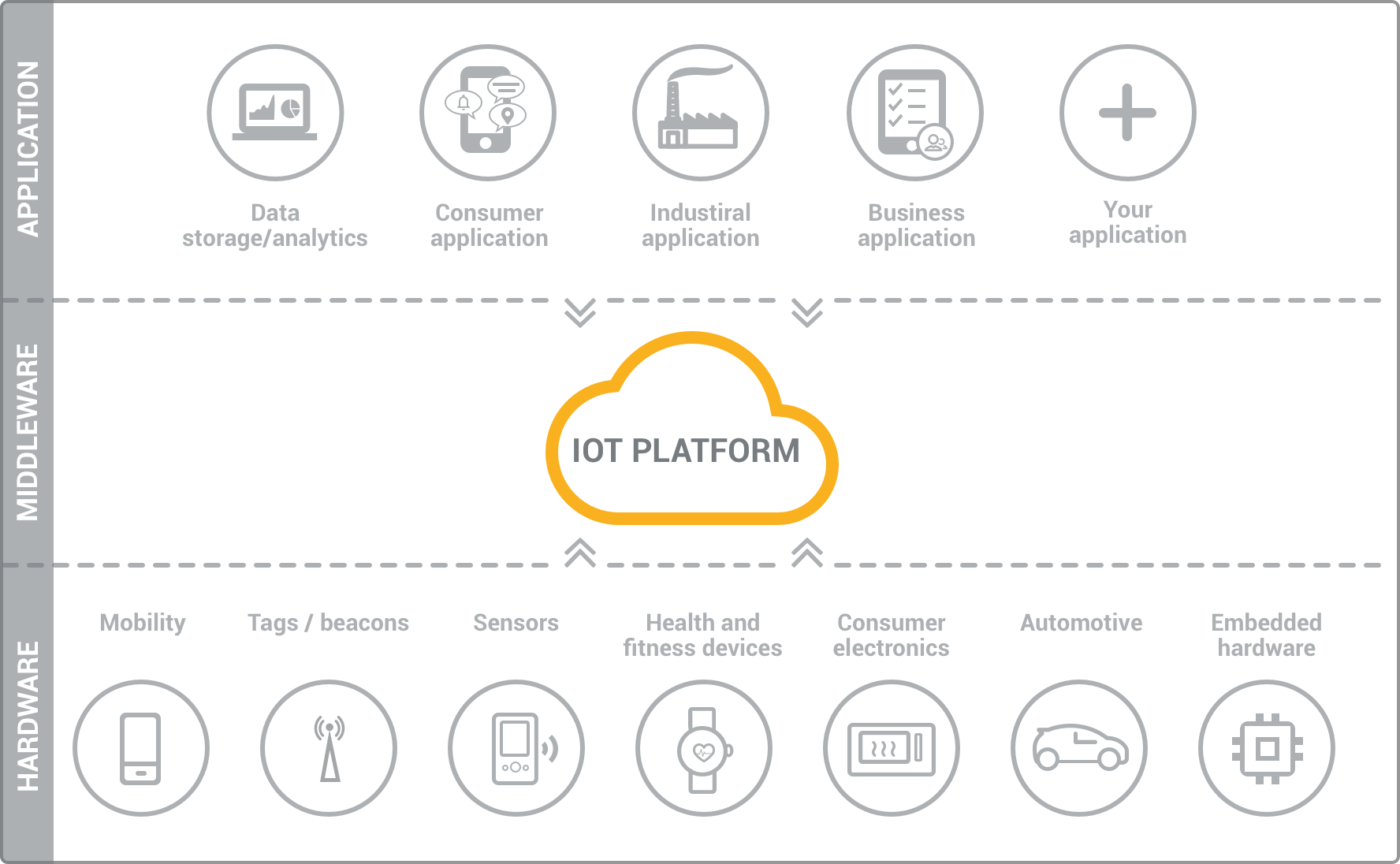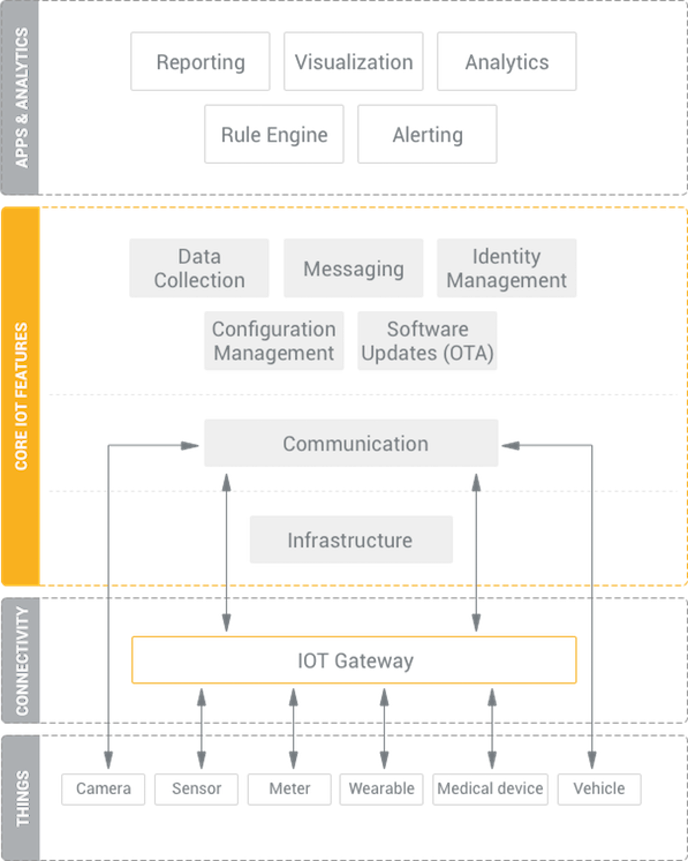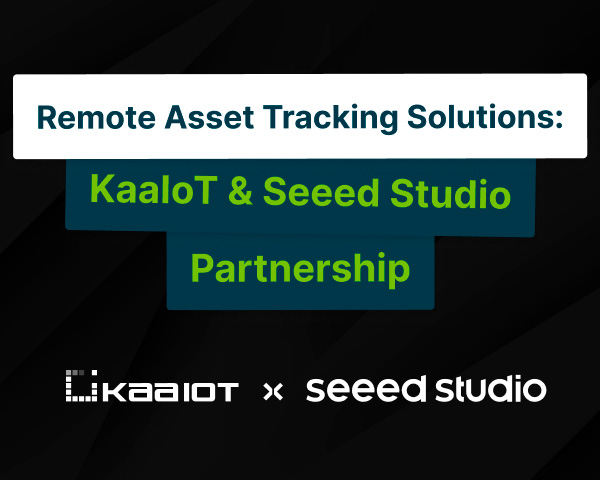What is an IoT platform?
The Internet of Things is an essential component of modern business operations, from consumer products to industrial automation. The complexity of managing, securing, and deriving value from these systems increases dramatically, given the pace at which organizations scale their connected device ecosystems. What used to be manageable with custom scripts and cloud dashboards now requires robust infrastructure to handle thousands or millions of endpoints, multiple communication protocols, diverse use cases, and stringent data security requirements. That’s where IoT platforms come in.
In this guide, we’ll break down:
- What an IoT platform is and what it does;
- Where it fits within the IoT technology stack;
- Core components and deployment options;
- What makes an IoT platform truly “advanced”;
- Key trends such as digital twins, edge AI, and cloud-native orchestration.
So, what is an IoT platform? Definition and overview
An IoT platform is a multi-layer technology that enables straightforward provisioning, management, and automation of connected devices within the Internet of Things universe. It basically connects your hardware, however diverse, to the cloud by using flexible connectivity options, enterprise-grade security mechanisms, and broad data processing powers. For developers, an IoT platform provides a set of ready-to-use features that greatly speed up development of applications for connected devices as well as take care of scalability and cross-device compatibility.
Thus, an IoT platform can wear different hats depending on how you look at it. It is commonly referred to as middleware when we talk about how it connects remote devices to user applications (or other devices) and manages all the interactions between the hardware and the application layers. It is also known as a cloud enablement platform or IoT enablement platform to pinpoint its major business value, which is empowering standard devices with cloud-based applications and services. Finally, under the name of the IoT application enablement platform, it shifts the focus to being a key tool for IoT developers.
The role of IoT platforms in the tech stack
An IoT platform sits at the core of any connected solution, serving as the connective tissue between physical devices, communication networks, and user-facing applications. Depending on its primary function, the platform may take on different roles: middleware, cloud enabler, or application enabler, each reflecting a specific layer of the IoT architecture.
IoT platform as middleware

IoT platforms initially emerged as middleware, designed to mediate between hardware and application layers. Their key responsibilities included data collection over diverse network protocols, remote device configuration and control, device management, and over-the-air (OTA) firmware updates. To function effectively in real-world, heterogeneous IoT ecosystems, middleware must support integration with nearly any connected device and third-party application. This hardware and software agnosticism allows a single platform to manage a wide variety of devices in a consistent, streamlined way.
Modern IoT platforms go beyond basic mediation. They also introduce features across both hardware and application layers, such as frontend components, analytics dashboards, on-device processing, and support for cloud-native deployments. Some platforms even enable end-to-end IoT solution implementation from scratch.
Cloud enablement and application enablement
IoT platforms are often called cloud enablement platforms when their value lies in bringing standard or limited-capability devices into cloud environments. These platforms support remote monitoring, control, and analytics, often with plug-and-play cloud services, enabling businesses to launch new services or business models. From a developer’s perspective, the platform becomes an IoT application enablement platform (AEP). In this role, it provides APIs, SDKs, visualization tools, and rapid prototyping capabilities, significantly accelerating the development and rollout of smart applications.
IoT platform technology stack

A well-architected IoT platform typically aligns with four layers of the IoT stack:
- Things – physical devices and sensors;
- Connectivity – communication protocols and gateways;
- Core IoT Features – device management, data ingestion, messaging;
- Applications & Analytics – dashboards, alerts, visualization, AI integration.
Connected devices can interface with the platform either directly or through an IoT gateway, especially useful when devices can’t communicate with the cloud on their own, or when edge computing is needed. Gateways can also act as protocol converters, for example, translating LoRaWAN traffic into MQTT messages suitable for cloud platforms.
Internally, an IoT platform itself can be decomposed into several architectural layers:
- Infrastructure layer – This foundational layer includes components like container orchestration, internal platform messaging, and cluster management.
- Communication layer – Provides secure and scalable messaging between devices and the cloud.
- Core IoT features – Encompasses essential services such as device provisioning, configuration management, telemetry collection, messaging, and OTA updates.
- Application & data processing layer – Focused on turning raw data into value. Includes features like custom reporting, rule engines, real-time analytics, data visualization, and anomaly detection through alerts.
Types of deployment: cloud, edge, hybrid
Modern IoT platforms are built to support flexible deployment models that can adapt to different business, technical, and regulatory requirements. The three primary deployment types are public cloud, private (self-hosted) cloud, and hybrid edge-cloud architectures.
Public cloud IoT PaaS
Many IoT platforms are offered as Platform-as-a-Service (PaaS) hosted in public clouds. This model allows companies to rent both the cloud infrastructure and the IoT platform from a single provider. It eliminates the need to manage hardware or backend infrastructure, making it ideal for startups, consumer product companies, and teams aiming for fast time-to-market. These platforms typically come with elastic scalability, automatic updates, and built-in support for multitenancy. However, they may have limitations in terms of custom integrations, source code access, and data control.
Private IoT cloud
Some organizations require more control over data, customization, and integration. For them, a private IoT cloud deployment is a better fit. This model allows the platform to be hosted on any infrastructure, including on-premises data centers or private cloud environments like AWS VPC or Azure Stack. Private deployments provide greater flexibility for adapting the platform to unique business needs, developing custom features, integrating proprietary services, and meeting strict compliance or data residency requirements.
Edge-cloud hybrid
For scenarios where devices generate large volumes of data or require ultra-low latency, an edge-cloud hybrid architecture becomes essential. In this model, part of the computing and data processing is handled locally on the edge (e.g., via an IoT gateway or edge server), while other operations are managed in the cloud.
Edge processing enables:
- Reduced bandwidth usage;
- Faster response times for time-sensitive applications;
- Offline operation during network outages.
A robust IoT platform should allow seamless orchestration of services across both cloud and edge environments, ensuring consistency in deployment, device management, and data processing.
What makes an advanced IoT platform?
Not all IoT platforms are created equal. While many offer basic device connectivity and data collection, advanced platforms stand out by supporting large-scale deployments, deep customization, strong security, and modern DevOps practices. These capabilities are especially critical for enterprise-grade IoT solutions.
Scalability
A top-tier IoT platform must support elastic scaling across thousands or millions of devices. This is straightforward in public cloud environments, but on-premises deployments require deliberate architecture design, including:
- Cluster load balancing;
- Resource orchestration;
- Fault-tolerant messaging and storage layers.
Customizability
Customizability is crucial for tailoring the platform to a specific use case or vertical. It includes:
- Well-documented APIs for smooth integration with external systems;
- Modular architecture with loosely coupled components;
- Support for custom plugins, data models, and deployment workflows;
- Source code access or SDKs for building proprietary extensions.
While simple solutions may work with basic APIs alone, complex or evolving ecosystems benefit from full control over platform internals.
Security
Security is foundational for any connected system. A secure IoT platform should offer:
- End-to-end data encryption (in transit and at rest);
- Fine-grained access control and user authentication;
- Secure device onboarding and identity management;
- Private cloud hosting options for sensitive data.
These features ensure protection against breaches and regulatory compliance across industries like healthcare, utilities, and finance.
DevOps readiness
As IoT systems evolve, teams need to continuously deploy, monitor, and optimize services. A DevOps-ready platform should support:
- CI/CD pipelines;
- Containerized deployment (e.g., Docker, Kubernetes);
- Automated scaling and failover;
- Centralized logging and observability tools.
This operational maturity helps reduce downtime, speed up iteration cycles, and maintain high availability in production environments.
👉 Compare top IoT platforms and their core capabilities to see which solutions meet your performance, security, and integration needs.
What your business can do with an IoT platform
An IoT platform plays a pivotal role for smart device vendors and startups, who can use it to equip their products with remote control and real-time monitoring functions, configurable alerts and notifications, pluggable cloud services, and integration with consumers’ smartphones and other devices. Another broad application of the IoT platform is cost optimization for companies in the industrial, agriculture, and transportation sectors through remote monitoring of devices and vehicles, predictive maintenance of equipment, collecting sensor data for real-time production analytics and ensuring safety, and end-to-end cargo delivery tracking.
Large-scale IoT clouds are typical solutions for CSPs, smart cities and smart energy integrators. By using an IoT platform, these companies develop IoT infrastructures for delivering a wide range of new services for regular customers, public service companies, and giant corporations. Among them are connected car services, smart grid metering, city-wide air quality monitoring, smart building deployments, and numerous others.
Finally, an IoT platform is the essential technology for improving customer experience in retail, healthcare, hospitality, and travelling domains. It is used to enable highly personalized services and ensure stress-free interaction between the customer and the company. A case in point is remote patient monitoring and treatment solutions, which are incredibly convenient to use and save a person a significant amount of time on regular visits to the hospital. Collecting thorough patient data becomes effortless with the IoT, whereas retailers and hospitality companies use rich data collection to create personal offerings and run effective marketing.
Strategic trends for IoT platforms
According to IoT Analytics, the number of connected IoT devices grew from 16.6 billion in 2023 and is expected to reach 18.8 billion by the end of 2024, with a projection of over 40 billion by 2030. The IoT plays a pivotal role in what they call “an intelligent digital mesh”, thus setting a higher bar for modern IoT platforms in several areas.
Digital twins – offer a more powerful way to monitor, control, and manage assets. Digital twins provide a comprehensive digital representation of real-world devices and systems, thus improving their state monitoring and enabling faster responses to external and internal events. Implementation of digital twins requires IoT platforms to provide highly flexible device management capabilities, which could cope with any level of sophistication depending on the use case. The applications of digital twins vary widely from asset inventory and predictive maintenance to event simulation and usage analytics. In the near future, they are expected to become a keystone of every efficient IoT ecosystem.
Intelligent things – utilize AI and machine learning to extract more insights from collected data and optimize their interactions within an IoT ecosystem. As basic IoT use cases have been successfully gaining ground, further enhancement offered by AI will galvanize even greater progress. Autonomous vehicles and robots at manufacturing facilities maximize production and delivery speed while unparalleled surveillance capacity provided by AI-supported security cameras radically transforms criminal justice systems. There are examples many in every sector of the economy. To allow for these cutting-edge solutions, IoT platforms must be designed to support flexible integration with AI systems and offer scalable, resilient device orchestration.
Cloud to the edge – places computing and data processing powers closer to managed entities in an IoT ecosystem. The combination of cloud and edge computing architectures enables all the benefits of a flexible cloud-native model, where separate services can be managed and distributed across connected assets in a scalable manner, while at the same time ensuring effective operation of disconnected entities and allowing them to take faster actions in response to new data. Considering other related tasks with cluster management in private cloud and multicloud environments, it is clear that an IoT platform has grown out of being a mere development tool and should be capable of handling DevOps as effectively.
Connecting the dots
IoT solutions are inevitably getting more complex and dynamic. They involve larger ecosystems of devices and evolve much faster than traditional enterprise application software. With the proliferation of all types of remote interactions between devices and humans, IoT solutions are also spearheading a new paradigm for customer-oriented digital experiences. Their complexity may seem intimidating at first, but in fact, taking advantage of the IoT is feasible at a fraction of the usual effort and without reinventing the wheel. For this purpose, an IoT platform is the new wheel.







